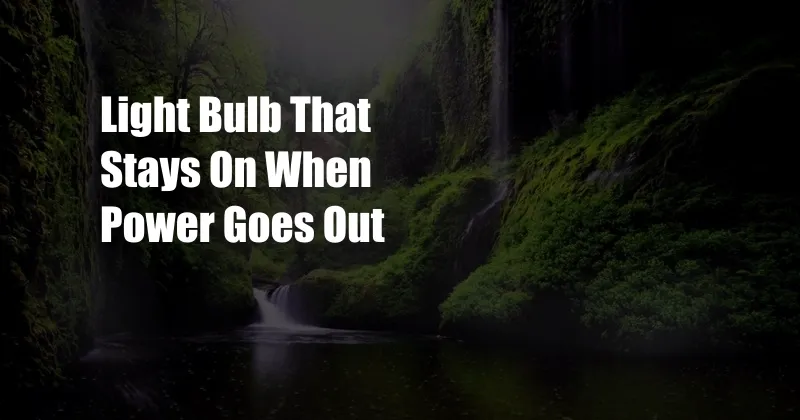
Light Bulbs That Stay on When the Power Goes Out
Imagine this: you’re cozied up on the couch, lost in a gripping novel, when suddenly, darkness envelops the room. Power outage! In the scramble to find candles or flashlights, you fumble around in the dark, cursing the sudden loss of illumination. But wouldn’t it be a lifesaver if there was a light bulb that could keep shining even when the power’s out?
Well, wonder no more! Light bulbs that stay on when the power goes out are a reality, offering a beacon of light in the darkest of times. These ingenious bulbs combine the convenience of electric lighting with the reliability of emergency backup systems, making them an invaluable asset for any home or business.
Unveiling the Magic of Blackout Light Bulbs
Blackout light bulbs, also known as emergency light bulbs, are specially designed to provide continuous illumination during power outages. Unlike traditional light bulbs that rely solely on electricity, these bulbs incorporate an internal battery that kicks in as soon as the power supply is cut off.
When the power is on, the battery charges itself while the bulb functions like any other regular light bulb. However, when a power outage occurs, the battery seamlessly takes over, powering the bulb for several hours, ensuring you always have a reliable source of light.
Exploring the Perks of Blackout Light Bulbs
The benefits of blackout light bulbs extend far beyond their ability to illuminate during power outages. Here are some of the key advantages:
- Peace of Mind: Knowing you have a reliable light source during emergencies can provide immense peace of mind. No more fumbling in the dark or relying on flickering candles.
- Safety: Blackout light bulbs help prevent accidents by providing visibility during power outages. This is especially crucial for elderly individuals or those with mobility limitations.
- Convenience: No need to search for batteries or candles when the power goes out. Simply rely on the built-in battery of the blackout light bulb for effortless illumination.
- Energy Efficiency: Blackout light bulbs often incorporate energy-efficient LED technology, reducing energy consumption while providing reliable lighting.
Tips for Choosing the Perfect Blackout Light Bulb
When selecting a blackout light bulb, consider the following factors:
Battery Life: Choose a bulb with a battery life that meets your specific needs. Consider the duration of power outages in your area and opt for a bulb that can provide ample lighting for the expected outage time.
Brightness: Determine the brightness level you require. Blackout light bulbs come in a range of brightness options, so choose one that provides sufficient illumination for your intended use.
Durability: Look for bulbs with durable construction and long lifespans. Blackout light bulbs are designed to withstand power outages, but choosing a robust bulb ensures reliable performance over time.
Frequently Asked Questions about Blackout Light Bulbs
Q: How long do blackout light bulbs stay on?
A: Battery life varies depending on the specific bulb, but most can provide several hours of illumination during a power outage.
Q: Can blackout light bulbs be used in regular light fixtures?
A: Yes, blackout light bulbs are designed to fit into standard light fixtures, making them easy to install and use.
Q: Are blackout light bulbs expensive?
A: Blackout light bulbs are generally more expensive than traditional incandescent bulbs but offer significant benefits and peace of mind during power outages.
Conclusion
Light bulbs that stay on when the power goes out are an invaluable tool for safety, convenience, and peace of mind. Whether you’re facing frequent power outages or simply want to prepare for emergencies, these bulbs offer a reliable and effective solution. By incorporating blackout light bulbs into your home or business, you can ensure that darkness never truly overpowers you.
Are you interested in learning more about blackout light bulbs and how they can enhance your safety and preparedness? Share your questions or experiences in the comments below, and let’s continue the conversation!